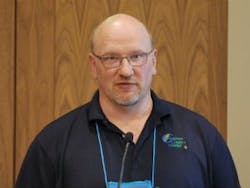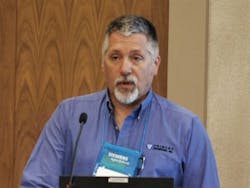"As the mismatch increased, the models were turned off." Golden Grain Energy's Chad Kuhlers on the ethanol producer's past experience with a high-maintenance APC solution.
Albert Einstein is credited with saying that any theory proposed to explain how the world works should be as simple as possible—but no simpler. Turns out, the same holds true when choosing control algorithms. From tried-and-true PID algorithms to outcome-oriented optimizers, the modern-day process control engineer has at his or her disposal an unprecedented array of tools designed to help tame even the unruliest physical phenomena. But it’s in knowing which of these tools best fits the problem at hand—the one that’s as complex as necessary but no more so—that differentiates the savvy process controls engineer from the pretender.
Craig Ebert is clearly no pretender. At Siemens Automation Summit 2019, the senior controls engineer for Trident Automation discussed the integrator’s optimization collaboration with Golden Grain Energy, a Midwestern ethanol producer based in Mason City, Iowa. The company produces some 120 million gallons of ethanol annually, and is owned by some 900 stakeholders—mostly local farmers.
“Our business is commodity in, commodity out,” explained Chad Kuhlers, chief operating officer for Golden Grain. “Margins are low, so operational excellence is a key differentiator.” That means reduced process variability, increased throughput, better quality product, reduced waste, reduced energy losses, increased safety and longer equipment life, Kuhlers added. All of these depend, in turn, on appropriately selected and properly maintained controls. That’s where Ebert and the rest of the Trident Automation team got involved.
Before engaging with Trident Automation, the ethanol-maker had in 2005 implemented a PC-based advanced process control (APC) solution that operated in supervisory mode with the company’s distributed control system. And while the company saw upticks in production and efficiency in the months that followed, those gains began to slip as the APC solution’s static models became mismatched with changing process biodynamics. “As the mismatch increased, the models were turned off,” Kuhlers said. So, when Golden Grain engaged Trident to take a fresh look at optimizing its processes, solutions that would deliver similar benefits yet were simpler—and less expensive—to maintain were given priority.
APC, meet MPC and ARC
While advanced process control (APC) has its place, it’s the best suited for multivariable optimization problems where multiple levers are used to achieve specific outcomes, such as throughput, energy efficiency, quality standards or emissions thresholds, Trident’s Ebert explained. Processes that require non-linear models or adaptive algorithms also help to justify an APC solution’s higher complexity and cost. APC solution development requires the most process modeling, engineering and programming time as well as extensive process knowledge. “They’re also harder for operators to understand and make adjustments,” Ebert said.
One step lower on the complexity scale is model-predictive control, or MPC, which involves a matrix of manipulated and control variables that interact with each other. It works well with linear and non-adaptive processes, and in modern control systems often resides within the DCS controller itself rather than in a supervisory PC. So, while the interactions of the multiple variables remain complex, operators and engineers can interact with MPC algorithms through an already familiar DCS interface. At Golden Grain, MPC is a controller-level option within the company’s SIMATIC PCS 7 environment.
While APC and MPC are powerful tools, it’s important to remember that they’re overkill for many tasks: basic and advanced regulatory controls are often the most appropriate tool for the job. Ebert classifies on/off, PI and PID strategies in the “basic” regulatory control category. “It’s important to get these right,” Ebert says. “They’re the foundation of more advanced methods.”
"It's important to get these right. they're the foundation of more advanced methods." Trident Automation's Craig Ebert stressed the importance of starting with properly implemented and tuned basic regulatory controls before tackling more advanced optimization approaches.
For those control challenges not tamed by properly tuned basic regulatory controls, Ebert calls first on ancillary regulatory techniques such as ratio, cascade, feedforward, reset windup, decoupling, overrides, bumpless transfers and gain scheduling. These advanced regulatory control, or ARC, strategies are relatively straightforward from a mathematical perspective and typically are configurable within the DCS controller environment. They’re also easier to implement and maintain—and easier for operators to follow and adjust in response to abnormal process conditions.
ARC and MPC at work
Ebert went on to describe a series of control challenges at Golden Grain that were solved with ARC and MPC techniques—avoiding the need for a standalone APC solution that would reintroduce greater complexity, costs and maintenance effort.
Dryer combustion control, for example, had been based on controlling fuel flow rate to maintain dryer outlet temperature constant. But the final control elements were prone to stiction, deadband and hysteresis; and changes in fuel pressure and process variability made the system difficult to tune. Aggressive tuning made the dryer swing out of control during process upsets leading to damagingly high inlet temperatures, but passive control tuning was ineffective as well. “Many times this loop was left in manual,” Ebert said.
To bring the dryers under control, the team added cascade control to the fuel and air flow rates as well as cross-limiting logic so that fuel couldn’t be added if air was inadequate, and vice versa. Constraint control of the dryer inlet temperature was added to eliminate top-end excursions. Automatic setpoint ramping was added so that transitions occurred in smoother, more orderly fashion. And feedforward control based on dryer input composition helped further tame process variability.
Consistent temperature control during fermentation was also an issue. Normally, temperature control is a straightforward loop based on temperature within the fermenter and cooling water flowrate. But in the early stages of a batch, when the fermenter is less than 15% full, the temperature probe was uncovered and operators had to make manual adjustments to the setpoint based on cooler water outlet temperature instead. Further, process dynamics varied considerably as the tank filled—more quickly responding to setpoint changes at lower fluid levels.
To tame these dynamics, Ebert and his team implemented conditional tuning logic based on fermenter fluid level. At 15% full, the system automatically switches from slower tuning constants (faster response) based on cooler outlet temperature to faster tuning constants (slower response) based on the fermenter temperature probe. Further, setpoint ramping eased transition from the early, higher temperature stage of the fermentation process to later, lower temperature stages. “This tighter temperature control significantly enhances yeast metabolism and ethanol production,” Ebert said. “Plus, variability is down, and batches are much more repeatable.”
Assisted by Trident, Golden Grain has also implemented model predictive control in several areas including its dryer, syrup and distillation operations. In the case of MPC, the algorithm implemented within the DCS works to accomplish multiple performance objectives against multiple disturbances. For example, MPC for the syrup draw from the bottoms of the beer column, which serves to distill 16% ethanol “beer” into a 95% (190 proof) ethanol stream for further purification, works to provide syrup of consistent density and maintain a constant temperature differential across the distillation column. Disturbance variables include beer feed rate into the column and the flow rate of thin stillage—the liquid that remains after the beer column bottoms have been centrifuged into cake and mostly liquid streams.
As this illustration shows, MPC implementations often are less intuitive that their ARC counterparts, requiring an engineering perspective on the dynamics involved. But a keen understanding of these interactions can yield DCS-based solutions to multivariable problems that once required a more complex, supervisory APC solution.
Advanced results, fewer hassles
For Golden Grain Energy, its investments in advanced regulatory and model-predictive control strategies that can be implemented and maintained within its DCS platform, have paid off—not only through improved consistency and performance of its processes, but also in lower maintenance costs to keep the solutions operational, concluded Golden Grain’s Chad Kuhlers.
“We don’t need an external computer to keep the benefits running,” Kuhlers said. One platform also means no finger-pointing between DCS and APC providers.
“The plant continues to produce well beyond our original nameplate,” Kuhlers added. “We have a very high conversion of corn to ethanol, and use substantially less natural gas and electricity that the original design point for the plant.”







